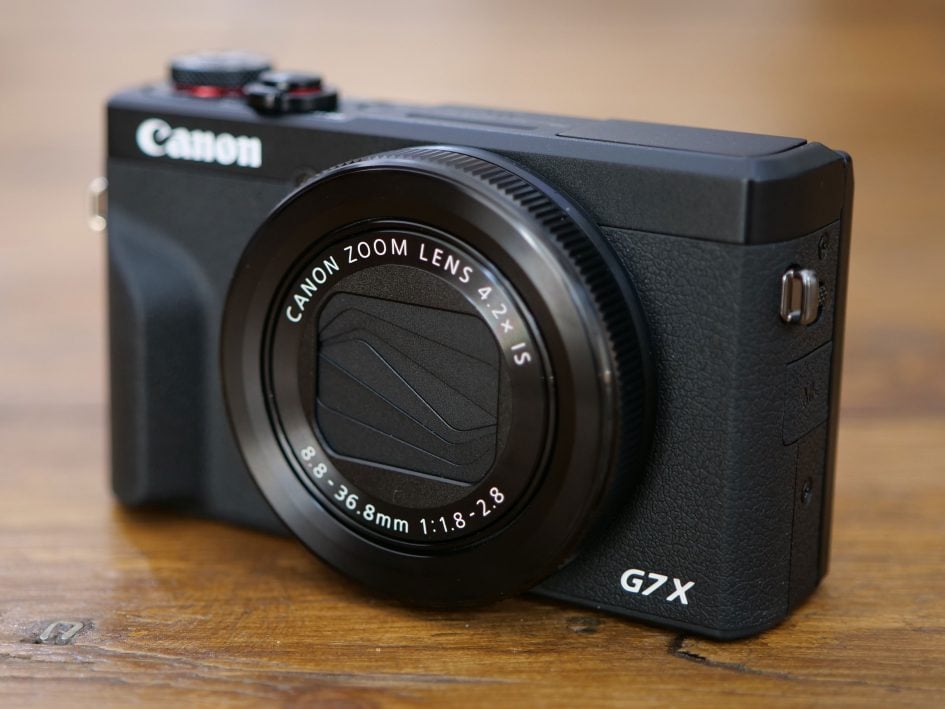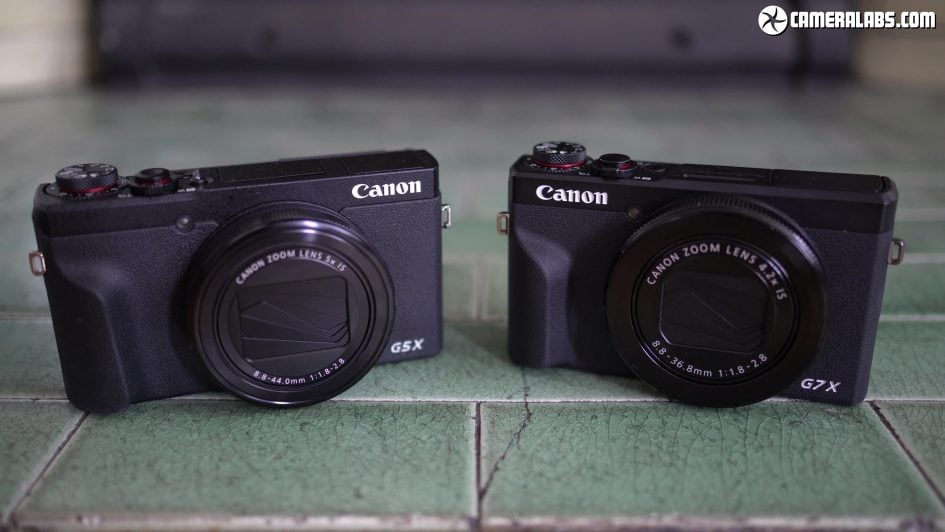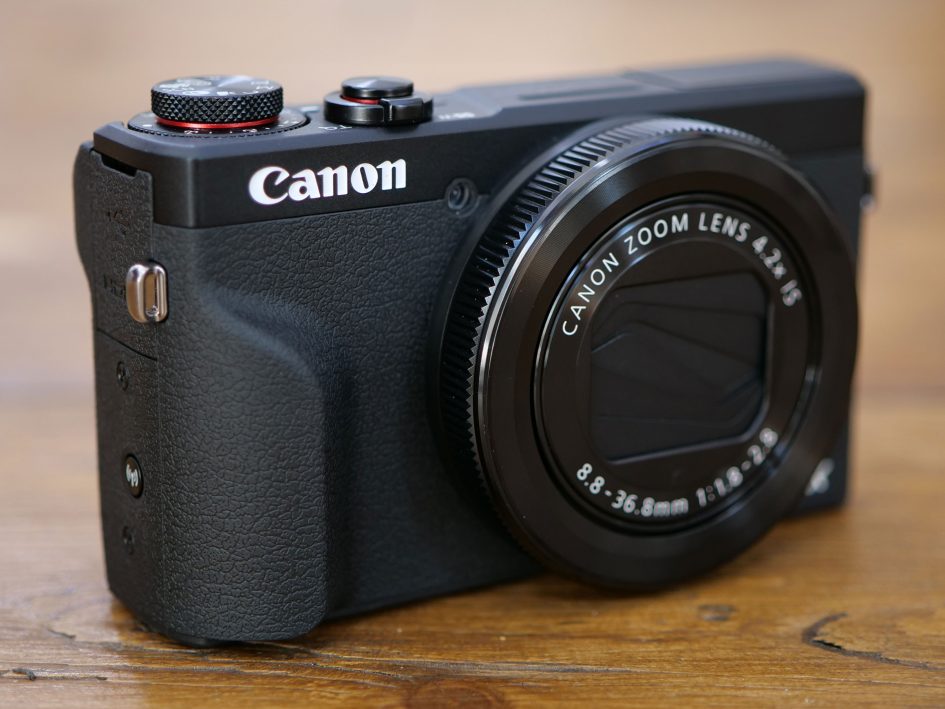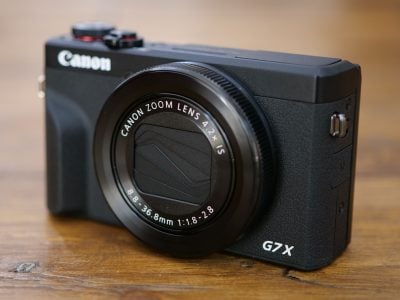Canon PowerShot G7X III review
-
-
Written by Gordon Laing
Verdict
The PowerShot G7X Mark III updates Canon’s most popular high-end compact with some unexpected features which will delight videographers and vloggers in particular. It keeps the earlier 24-100mm lens and much the same body and controls, but beefs-up the display mechanism for vloggers who casually hold it by the screen, adds a 3.5mm microphone input, the chance to live stream direct to YouTube over Wifi, and allows you to keep vertically-formatted video filling the screen for IG stories and other phone platforms – all firsts for a compact with a 1in sensor, although Sony’s even higher-end RX100 VII joined it with a mic input shortly afterwards.
Of these new features, the mic input is arguably the most important, allowing a potential upgrade in sound quality on your videos. In the absence of a hotshoe, you’ll need to use some kind of bracket to mount a shotgun or wireless transmitter, but the Sony’s no different and it’s no big hassle; you could alternatively simply connect a wired lav straight to it. Either way connecting a decent mic and getting it close to you really improved the sound quality on my videos, and amazingly the G7X III and RX100 VII are the only two pocket compacts with the facility so far; I’m excluding the Sony RX0 as it’s a specialist action camera with a fixed lens.
The G7X III’s live streaming was less successful for me, but this was due to my poor internet speeds at home and on mobile. All I can say is it worked, but for no more than a couple of minutes at a time, so it wasn’t a practical solution for me personally. Your mileage will vary, but you should aim for at least a 5Mbit upload. The vertically-formatted video worked a treat though and I should note Canon’s Camera Connect mobile app successfully copied videos with sound to my Galaxy S7 phone, whereas Sony’s Imaging Edge app only imported videos without sound. This is due to an incompatibility between Sony’s XAVCS format and Android phones, forcing you to convert videos on a computer first, but either way it was easier to post IG Stories straight from the Canon.

The G7X III continues to employ a 1in sensor with 20 Megapixels, but Canon’s upgraded to a stacked CMOS design that supports 4k video at 25 or 30p, 1080 slow motion up to 120p (with fixed focus and no audio), and fast burst shooting at 20fps or in a RAW-only mode at 30fps with a pre-buffering option; note both top speed modes are for Single AF only, with speeds dropping to 8fps if you want continuous AF.
Eagle-eyed camera geeks will guess the sensor is probably the same one from Sony’s older RX100 IV which means the G7X III may gain 4k and extra speed but sadly not the phase-detect AF introduced on the later RX100 Mark V. Strangely the G7X III also lacks 24p video (available on the Mark II) and continues to lack eye-detection too. Canon’s also resisted fitting a viewfinder, leaving it to the pricier G5X II, which means Sony’s RX100 IV and V remain compelling alternatives with their popup finders.
As before the ergonomics and quality out-of-camera remain highlights, with a surprisingly comfortable grip and tactile controls coupled with great-looking JPEGs and 1080 video. The new 4k video certainly records more detail than the 1080 footage, and allows clips lasting 10 minutes versus five on the RX100 models using the default settings. But Sony’s 4k footage contains finer details, and if you switch off the heat warning on the latest RX100 VII, it’ll keep recording 4k for an hour, although will become very hot to touch. In contrast, the G7X III shut itself down for cooling after recording only a clip and a half of 4k (that’s 15 minute’s worth), even though the body was barely warm to touch. Clearly Canon’s a lot more heat-averse than Sony.
The continuous autofocus and burst shooting on the Sony also remain far superior. Sure, the G7X III may now shoot at 20fps (or even 30fps in the new RAW burst mode), but both are with fixed focus. Set the camera to Servo for continuous AF and the burst speed not only drops to 8fps but you also lose face detection and are limited to a single AF frame. In contrast, the RX100 VII will shoot at 20fps with full continuous autofocus across almost the entire frame, complete with face and even eye-detection, not to mention zero blackout.
Phase detect autofocus on the Sony also means videos focus more confidently, which is invaluable whether you’re in front or behind the camera. Sony offers this superior AF performance on the RX100 Mark VA, VI and VII, and all three are also equipped with popup viewfinders lacking on the G7X III, but all are also comfortably more expensive. Even the cheapest of the three Sonys with decent AF, the RX100 VA, is around one third more expensive than the G7X III and while the Sony focuses more confidently and sports a viewfinder, the VA’s zoom range is shorter than the G7X III and it doesn’t even have a touchscreen. In October 2019, Canon released a firmware update to address concerns over the G7X III’s somewhat lacklustre autofocus performance for video. This adds two modes in the Servo AF menu: Mode 1 is the new, more responsive option, while Mode 2 performs similarly to the original release. In my tests, Mode 1 is definitely much faster at acquiring and adjusting focus, although there’s still inevitably some breathing from the contrast-based system. So Sony’s phase-detect system remains more confident, but at least the G7X III now matches the speed and response of the G7X II, or arguably improves on it.
The bottom line is the G7X III may not be as powerful or confident as the recent Sony’s in terms of bursts and autofocus, but its capabilities remain sufficient for most of its target audience, the images and controls look and feel better to me personally, and crucially, it’s a lot cheaper. In contrast the top Sony RX100 VII is sufficiently expensive for you to question whether you should buy an interchangeable lens camera with a bigger sensor instead.
Canon G7X II vs G7X III
If you’re one of the many owners of the previous G7X II, you’ll be wondering if it’s worth upgrading to the Mark III. The body, lens, screen and photo quality are all essentially unchanged, so it boils down to how much you’d exploit the 4k video, mic input, YouTube live streaming and faster burst shooting. Of all the new features I feel the the mic input is the most useful, but if you only want the G7X III for this single aspect, you could alternatively stick with the Mark II and use it with an external sound recorder like the Zoom H1N – so long as you don’t mind syncing audio when editing afterwards. If you think you’d exploit two or more of the new features though, or simply want the chance to upgrade the audio without mucking about with syncing, then the G7X III is a tempting choice, and the lens also seems to be less audible when filming too, although annoyingly the Mark III loses the 24p video options of the Mark II. If you want a big upgrade in autofocus over the Mark II though, you’ll need to spend more on a Sony RX100 VA, VI or VII, and of them, only the latest VII gives you a mic input too.
Canon G5X II vs G7X III
Following an unexpected change in design, the closest rival to the G7X III has in fact become Canon’s own G5X II launched alongside it. The G5X II now shares the same body design and control layout, not to mention essentially the same photo and video quality as well as many other key features. Indeed it’s quicker to just say what makes them different: a slightly longer (and slightly sharper) 24-120mm zoom with closer focusing at the long end and a popup viewfinder on the G5X II versus the mic input and live streaming of the G7X III at a slightly lower price. You choose.

As such Canon’s clearly targeting the G7X III more to vloggers and the G5X II more as an EOS companion for still photographers, although since they both share essentially the same photo and video quality, they can both be used for the same jobs. Indeed you can’t help but wonder if it wouldn’t have been better to merge them both and have a single camera with all the new features? Of course most vloggers won’t need a viewfinder or a longer zoom and will prefer the current G7X III configuration at its lower price, but many hybrid shooters would appreciate a merged feature-set. Perhaps two version with and without a viewfinder would have been a more sensible choice?
Personally speaking as a hybrid shooter, I’d go for the G5X II for its viewfinder, slightly longer zoom (that’s also slightly sharper than the G7X III’s lens and focuses twice as close at the telephoto end too), and simply use an external sound recorder like a Zoom H1N when required, but having to choose features would also make me look towards Sony and wonder if they’d ever do an RX100 VA with a mic input. Even if they did though, I remain very fond of Canon’s output and ergonomics.
See my Canon G5X II review for more details.
Also consider the Sony RX100 VA which costs one third more, has a shorter 24-70mm zoom and no touchscreen or mic input, but sports a popup viewfinder and the confidence of phase-detect autofocus.
Canon G7X III final verdict
With the G7X III and G5X II, Canon’s delivered a pair of classy compacts which capture great-looking photos and videos with a number of useful upgrades over their predecessors – some shared such as the 4k video and fast burst shooting, while others steer them towards specific tasks. While both models deliver essentially the same quality photos and videos, the mic input and live streaming make the G7X III more appealing to vloggers, while the viewfinder and slightly longer (and slightly sharper) zoom of the G5X II will attract stills photographers; the choice is yours.

Sony’s RX100 series continues to take the lead in burst shooting and especially continuous autofocus, comfortably out-classing both Canons in these respects. It’s a shame that Canon didn’t – or couldn’t – use the newer sensor deployed in the RX100 VA onwards to enjoy the confidence of phase-detect autofocus, and you really notice the difference when photographing or filming subjects in motion. Sony also continues to offer video at 24p when it’s mysteriously disappeared from the Canons.
But while it’s easy to criticise Canon on falling behind Sony in terms of autofocus, bursts with tracking, 4k quality or even a single-action viewfinder, it’s important to take pricing into consideration. Yes the RX100s do a great deal but of the latest three models with superior autofocus, the cheapest VA remains one third more expensive than the G7X III and the priciest Mark VII is comfortably into four-figures. In contrast, the two Canons are comfortably cheaper making them an easier prospect to swallow.
The G7X Mark III in particular hits a sweet-spot in pricing that will greatly appeal to the vlogging market it’s aimed at. Yes you may need to wait for the autofocus to catch up at times, but you’re getting a comfortable body with a flip screen and tactile controls, a decent zoom range, great-looking photos and video out-of-camera, the potential for superior sound with a mic input and if your internet connection is fast enough, the chance to live stream direct to YouTube over Wifi. That’s a compelling feature-set and one that earns the G7X III a Highly Recommended award!
Check prices on the Canon PowerShot G7X III at B&H, Amazon, Adorama or WEX. Alternatively get yourself a copy of my In Camera book or treat me to a coffee! Thanks!



